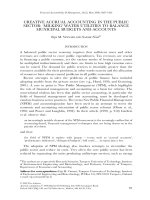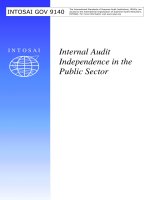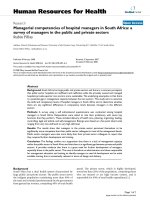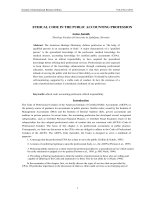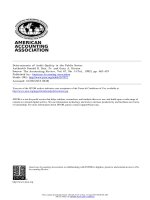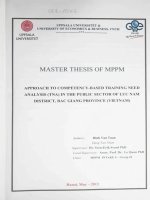Accrual accounting in the public sector
Bạn đang xem bản rút gọn của tài liệu. Xem và tải ngay bản đầy đủ của tài liệu tại đây (137.76 KB, 33 trang )
Fédération des
Experts Comptables
Européens
ACCRUAL ACCOUNTING
IN THE PUBLIC SECTOR
January 2007
A Paper from the FEE Public Sector Committee
CONTENTS
Executive Summary .................................................................................................................................4
Introduction ....................................................................................................................................4
Nature of this paper ........................................................................................................................4
Methodology and results ................................................................................................................5
Key Messages.................................................................................................................................6
Conclusions and Recommendations ...............................................................................................6
1.
Introduction ....................................................................................................................................8
What is accrual accounting? ...........................................................................................................8
What is the difference with cash accounting? ................................................................................8
What are the relative merits of accrual and cash accounting?........................................................9
Why has FEE produced this paper?................................................................................................9
Methodology followed .................................................................................................................10
Contents of this paper ...................................................................................................................11
2.
Analysis of the Responses ............................................................................................................12
Introduction ..................................................................................................................................12
Nature of the questionnaire...........................................................................................................12
Analysis of the data set.................................................................................................................12
Which areas are most likely to be accounted for on an accruals basis? .......................................14
Which countries are leading the way for the implementation of accrual accounting? .................20
Trends identified in the data set....................................................................................................21
3.
Commentary on areas of debate ...................................................................................................25
Introduction ..................................................................................................................................25
Area 1: The depreciation and valuation of assets .........................................................................25
Area 2: The recognition of gains and losses in the Statement of Performance ............................26
Area 3: The recognition in the financial statements of variances against budget.........................27
Area 4: The recognition in the financial statements of state pension liabilities ...........................27
Commentary on the areas examined.............................................................................................27
Annex A: The Accrual Accounting Questionnaire ................................................................................29
Annex B: List of Countries from which a response to the questionnaire was received .........................33
3
Accrual Accounting in the Public Sector
January 2007
EXECUTIVE SUMMARY
Introduction
Cash accounting is where transactions are recorded when money is paid or received. In contrast,
accrual accounting is a method of recording financial transactions where the full characteristics of
those transactions are recorded in the period to which they relate.
Accrual accounting is the accepted method of accounting worldwide for the private sector.
Increasingly, the public sector is also moving towards accrual accounting as it helps governments to
obtain a better picture of the performance of their policies.
Accrual accounting facilitates better planning, management and decision making as well as providing
a means with which to assess financial resilience. It can also assist better performance measurement
and therefore performance management. So accrual accounting provides scope for organisations to
manage their finances more effectively. It can permit more effective comparisons of some aspects of
financial performance between different government departments and agencies as well as international
comparisons. Comparison between government services for the purposes of competitive tendering as
well as pre and post privatisation can also be made more readily if both sets of financial statements are
prepared on the same basis.
FEE supports the move from cash to accrual accounting. FEE has published a number of papers on
topics in connection with accrual accounting. For example, in February 2006, FEE published a
Statement “Better Financial Information for Better Decision Making” and an Alert “Accrual
Accounting for More Effective Public Policy” setting out the benefits of accrual accounting and
promoting an understanding of accrual accounting. This paper discusses the current status of accrual
accounting across Europe.
The accountancy profession has an important role to play in the move to accrual accounting in the
public sector. The profession can bring its experience of the private sector to assist the implementation
of accrual accounting in the public sector. Accountants employed in the public sector entity will be
able to help others within the entity to understand better accrual accounting. There are also
accountants in public practice whom the public sector entity can consult on technical issues and from
whom it can obtain additional human resources for the transition. Finally, part of the duties of an
auditor is to check whether the financial statements have been prepared in accordance with the
generally accepted accounting principles and in accordance with accepted financial reporting
standards.
Nature of this paper
FEE decided to produce this paper for a number of reasons:
•
The trend for accounting in the public sector in Europe is away from the traditional cash based
accounts and towards the adoption of accruals based accounts. For example the European
Commission has prepared its first accruals based financial statements for 2005. FEE therefore felt
that it would be useful to produce a document that set out what progress had been made in this
area;
4
Accrual Accounting in the Public Sector
January 2007
•
It is well documented which countries throughout Europe are using the cash basis (for example
Italy and Germany) and which are using the accruals basis (for example the UK) at a national
government level. Whilst a cash or modified accruals basis is still common at that level, FEE felt
it would be an interesting exercise to determine the level of use of the accruals basis at all levels
of public administration;
•
As countries move towards the accruals basis, it is becoming more likely that they will use
International Public Sector Accounting Standards (IPSAS) as the basis for introducing accounting
standards in those countries. For example, France has legislated for the introduction of a modified
version of the accruals based IPSAS from 2007; and
•
It was felt that by reporting on the state of implementation of accrual accounting it would be
useful for those about to make the transition to be aware of some of the issues that the
frontrunners have faced.
Methodology and results
The key document used to prepare this paper was a questionnaire that was sent to selected public
authorities in European countries via their FEE Public Sector Committee representative. This was first
circulated in early 2005 and reissued in late 2005 to clarify some of the questions asked. The
questionnaire is at Annex A.
A number of countries replied to the questionnaire or else provided comments on the state of
accounting in their country. A list of those which responded is at Annex B.
The questionnaire responses were then analysed and reported in this document. In chapter 2 there is
analysis and commentary on the data set received, as well as some analysis of the trends identified
from the data set. In chapter 3 there is commentary on the responses to some questions around the
edges of accruals principles which were framed in the questionnaire.
Important message when interpreting the results
Responses were received from up to five tiers of government in the individual countries, from national
government to local administrations. A country where the national government was using the cash
basis, but some form of accrual accounting is followed at the lower levels of government could score
four positive results out of five, meaning an implementation rate of 80 per cent.
The rate of 80 per cent should therefore be interpreted as: “80 per cent of those who responded on
behalf of (their part of) the public sector in their country said that they were following accruals
principles, or a modified form of them”.
The rate should not be interpreted as the proportion of countries which have implemented accrual
accounting. In the example, the government has not adopted accrual accounting, but the results show
that parts of the public sector are following the principles.
5
Accrual Accounting in the Public Sector
January 2007
Key Messages
From the results of the questionnaire we can make the following observations:
•
Across the survey group we have found approximately an 80 per cent implementation rate (see
page 21 section ‘the overall trend towards accrual accounting’). Whilst the number of countries
which can be said to have made the full transition to accrual accounting is small, our survey
provides evidence that across the full range and size of public bodies there is a large proportion
where some form of accrual accounting has been adopted;
•
It is more likely that public bodies in Northern European countries are using the accruals basis
than in Central and Southern European countries;
•
The experience of those using accrual accounting is that it takes longer to implement the accruals
principles for tax revenues, provisions and grants than for operating expenses;
•
A number of countries are well down the road of accrual accounting, but there is a group that are
currently in transition and a smaller group which are still using cash;
•
Where accrual accounting has been implemented for a number of years, the data shows a high
level of consistency in terms of compliance with the accrual accounting principles. Where
implementation is more recent it is much more likely that the accruals principles are currently
being modified as part of a transition period;
•
Accrual accounting is significantly more likely to have been implemented at a local government
level than at the national government level. The overall implementation rate being at 80 per cent
of respondents reflects that fact that many local and regional public bodies follow some form of
the accrual principles, even when the national government is still on a cash basis; and
•
There are a number of areas where there is still much discussion around implementation of the
accruals principles (the ‘debatable cases’). Where accounting standards are not in place there is
scope for individual interpretation of those principles.
Conclusions and Recommendations
The data suggests that the more common approach to implementing accrual accounting is to make the
transition first at a local level and only later transfer the implementation of accrual accounting to the
national government. The advantage to taking this approach is that lessons can be learned from the
local implementation to be incorporated into the approach for making that transition at a national level.
Under this approach, it is important that at the local level similar principles are followed by all bodies
to retain consistency and transparency.
The results show that the use of accruals principles for certain areas is significantly behind other areas.
The most common example is the recognition of tax revenues which for many countries is still on a
mainly cash basis where the rest of the financial statements are on an accruals basis. This would
appear to be due to the challenge in finding an appropriate accounting policy. In contrast, the
recognition of operating income and expenses on an accruals basis is a much simpler concept to
implement. FEE would recommend that where countries are deciding to implement the accruals basis,
they give early consideration to the best way to incorporate such challenging areas into the accruals
based financial statements.
6
Accrual Accounting in the Public Sector
January 2007
There is significant scope under the accruals principles for interpretation. Countries must adapt those
principles to their own circumstances. A common example is whether to value assets at historic cost or
whether to revalue those assets to fair value. This is a choice under the available standards on asset
accounting. However, it is in the area of the debatable cases that the significant inconsistencies appear.
In chapter 3 we have highlighted some of the cases which are not necessarily covered by accounting
standards and are therefore open to interpretation. FEE takes the view that it is important to have a
common set of standards employed by all, and supports principles based accounting allowing for
application taking into account the specific national circumstances.
There has been much recent debate about the need for a public sector Conceptual Framework. It is
undeniable that such a framework could assist preparers of accounts, in particular for situations where
no defined accounting standards exist and therefore assist public sector administrations in preparing
their financial statements. Improved consistency would also enhance one of the main objectives of any
financial statements – that accounts are comparable over time and between organisations enabling an
assessment of the performance of the public sector to be made. FEE therefore supports the initiative
adopted by IPSASB for a Conceptual Framework which takes into account the specific needs of the
public sector.
7
Accrual Accounting in the Public Sector
January 2007
1.
INTRODUCTION
What is accrual accounting?
Accrual accounting is a method of recording financial transactions where the full characteristics of
those transactions are recorded in the period to which they relate. All assets owned by the organisation
at the end of the period and all liabilities which exist at that point is also recognised in the financial
statements. In particular it records revenues earned and resources consumed in a period rather then
simply reflecting the cash movements. This allows the following to be prepared:
•
A comprehensive statement of the position of an organisation at the end of a period; and
•
A comprehensive statement of performance of an organisation during the period.
Under accrual accounting cash flow statements are still required to be produced. This provides
information on the entity’s use of resources and liquidity.
Accrual accounting is the accepted method of accounting worldwide for the private sector.
Increasingly, the public sector is also moving towards accrual accounting as it helps governments to
obtain a better picture of the performance of their policies. The European Commission has recently
completed a project to introduce its own financial statements from 2005 onwards.
Accrual accounting is formalised in International Standards. For the public sector the IFAC IPSASB
produces International Public Sector Accounting Standards (IPSAS). These are broadly based on the
corresponding International Accounting Standards but are modified to clarify aspects which
particularly affect the public sector. It is not mandatory for public sector bodies to adopt IPSAS.
However, it is becoming increasingly likely that countries which are moving to accrual accounting
will either adopting the accruals based IPSAS in full or use them as the basis for developing their own
standards which take into account the particular circumstances in their country.
What is the difference with cash accounting?
Cash accounting records the cash effects of a transaction in the period in which they occur. Under this
regime monies paid and received are recorded in the financial statements of an organisation.
Key elements of accrual accounting
•
Income is recorded only when it is due, not when it is received.
•
Expenditure is incurred when due, not when it is paid out.
•
Assets are recorded when they belong to the organisation and when a future benefit will be
received from holding the asset.
•
All likely liabilities must be included.
•
The question of whether an organisation is solvent must be reflected.
8
Accrual Accounting in the Public Sector
January 2007
What are the relative merits of accrual and cash accounting?
Accrual accounting facilitates better planning, financial management and decision making in
government as well as a robust and accepted way of measuring the economy, efficiency and
effectiveness of public policies. Further, one of the objectives of financial reporting is to allow
accurate comparison to be made between different organisations. By using the accruals basis for
public financial statements, there is increased comparability of public sector and private sector
organisations, whilst retaining the comparability of an individual organisation on a period by period
basis.
Cash accounting makes little or no reference to the liabilities that an organisation will be required to
meet in the future, nor does it recognise the benefits that will be obtained from purchased assets over a
period of time. Financial statements prepared on a cash basis therefore give limited information of use
to financial managers and decision makers. In practice, most countries still using cash accounting do
produce periodical balance sheet information.
At the beginning of the transition process, there is a risk that financial statements prepared on an
accruals basis are less readily understood than those prepared under the cash basis. To mitigate this
risk it is important that the reader has a solid grounding in the principles of ‘assets’, ‘liabilities’,
‘income’ and ‘expenditure’. This enables the legislature to effectively hold the executive to account
and the executive to defend its position robustly.
Accrual accounting can, however, be presented in a format such that non-accountants can understand
the key messages. When this is achieved, for example by the highlighting of key performance
indicators, the benefits to decision makers of the accruals-based accounts is realised.
In contrast, the move to accrual accounting does involve significant on going costs and risks. For a
more detailed discussion of the impact of the introduction of accrual accounting please see the FEE
paper from 2003 “The Adoption of Accrual Accounting and Budgeting by Governments”. This is
available at www.fee.be/publications/main.htm.
Why has FEE produced this paper?
There has been a gradual shift in Europe away from cash accounting towards the introduction of
accruals-based financial information. However, the pace of change has varied widely between
individual countries, and some are only now in the process of fully implementing reforms of their
accounting systems.
The purpose of this paper is therefore to document at what stage European countries are at regarding
the implementation of accrual accounting, and to share the experiences of those who were early
adopters of accrual accounting with those who are currently undergoing the reforms.
The implementation of accrual accounting can be said to be one aspect of reforms under New Public
Management (NPM). FEE has produced a report on the state of NPM-style reforms in European
countries which can be found at />This paper also recognises that the decision to remain with cash accounting is a choice on behalf of the
policy makers in those countries. FEE supports the move from cash to accrual accounting, but the
objective of this paper is to discuss the current status of accrual accounting across Europe.
9
Accrual Accounting in the Public Sector
January 2007
Methodology followed
FEE produced a survey questionnaire which was sent to selected public authorities in European
countries via their Public Sector Committee representative. The survey was in two parts:
•
Part one addressed the meaning of accrual accounting in the public sector and asked countries to
respond how the question was being applied in their own circumstances;
•
Part two highlighted some current areas of debate in the field of accrual accounting and asked
countries to respond with their current thoughts and policy in the areas under question.
Part One: Areas examined by the survey questionnaire
•
Recognition of fixed assets including the basis of initial valuation, the measurement of
depreciation and the treatment of maintenance costs.
•
The range of fixed assets recognised for example heritage assets, military assets and assets under
construction.
•
How fixed assets are recognised in opening balance sheets.
•
How stocks (inventories) are recognised and accounted for.
•
The policy for recognition of income and expenses, including tax revenues and grant income /
expenditure.
Part Two: Areas of debate highlighted in the survey questionnaire
•
The policy for the depreciation and valuation of assets.
•
Recognition of gains and losses in the statement of performance.
•
Recognition of budget variances in the financial statements.
•
Recognition of state pension liabilities / employee benefits.
The responses to the questionnaire were collated by FEE and this report written based on those
responses. A number of cautions should be highlighted to those reading this report:
•
The report is based solely on the results from those countries which responded. The trends
identified are of necessity limited to those responses and no assumptions should be inferred from
those countries from which responses were not received;
•
The way that the questions were framed was open to interpretation by the respondents depending
on their own circumstances. It cannot be assumed that there was 100 per cent consistency in the
way that the questions were answered;
10
Accrual Accounting in the Public Sector
January 2007
•
As highlighted in the Executive Summary, the interpretation of the results should be treated with
care. A positive result in our survey arises when an organisation produces some kind of relevant
accruals based information. This need not be the production of full accruals based financial
statements.
More detail on the nature of the questionnaire and the public bodies to which it was sent is given in
paragraph 2.2.
Contents of this paper
This report has been produced to highlight the results from the questionnaire which was sent to the
various levels of public administration in European countries. A copy of the questionnaire is presented
at Annex A and a list of the countries who responded is at Annex B. The findings from the responses
have been structured as follows:
•
In Chapter 2 there is an analysis of the data received. This shows the scale of the implementation
of accrual accounting across the survey countries. There is also examination of the responses by
account area, and a discussion of that state of implementation of accrual accounting in the
respondent countries;
•
Chapter 2 also contains an analysis of the trends in the data received. This will look at whether
there are trends across countries, across the different levels of government in those countries, and
across different account areas (for example the recognition of tax revenues);
•
In Chapter 3 there is a commentary on the areas of debate on which we asked for opinions in the
questionnaire;
•
Key messages and the conclusions and recommendations arising have been highlighted in the
Executive Summary to this report.
Whilst the analysis is of necessity limited to those European countries who responded to the accrual
accounting questionnaire we hope, nevertheless, that the results will be of interest to other countries
who are undergoing, or are considering, the reform of their accounting systems.
11
Accrual Accounting in the Public Sector
January 2007
2.
ANALYSIS OF THE RESPONSES
Introduction
The questionnaire on accrual accounting in the public sector was first issued in March 2005. Initially,
twelve responses were received. From an analysis of those responses it was determined that there had
been different interpretations of some of the questions. As a result FEE decided to clarify and re-issue
the questionnaire in September 2005. A total of nineteen countries responded to the revised
questionnaire. The revised questionnaire itself is attached at Annex A and the list of countries who
responded is at Annex B. In addition to the nineteen respondents, FEE also received comments from
Italy, Slovenia and Sweden on the status of accrual accounting in their own countries – these countries
felt that the questionnaire was not broad enough to accurately reflect their own circumstances.
Nature of the questionnaire
The questionnaire contains 33 questions in the first part which deals with the extent to which accrual
accounting is applied across the survey group. The questionnaire asked for responses on the practice of
accrual accounting at five levels of government: municipality, small region, large region, national
government and government agencies. Each country was therefore required to adapt its own public
sector structures to fit this analysis.
As a result, FEE received a total of 1,921 responses from the survey group. A different number of
responses were received from each country as not each level of government is represented in each
country.
Analysis of the data set
The data can be analysed and presented in a number of ways. This paper will ask whether the data can
provide answers to the following questions:
•
To what extent is accrual accounting being applied across the survey group as a whole? This will
take all of the results – for all countries, levels of government and account areas – and come to a
total conclusion about the level of implementation;
•
Which areas are most likely to be accounted for on an accruals basis? This will look at the
responses to the individual questions and identify those areas which are leading the way in terms
of being accounted for using accruals;
•
Which countries are ahead in the implementation of accrual accounting? This will look at the total
responses on a country basis and identify those countries which are more advanced in terms of
moving to the accruals basis.
The data also allows an analysis of any trends that might be identified such as:
•
Is there an overall trend in the use of accrual accounting?
•
Are there any geographical patterns in the level of implementation of accrual accounting?
12
Accrual Accounting in the Public Sector
January 2007
•
Is there a link between the implementation of accrual accounting and the status of reforms
characterised under New Public Management?
•
Are there differences of similarities in the level of implementation of accrual accounting
depending on the level of government examined?
Note that answers of not applicable, or where no answer was given as the question was not relevant,
have been removed from the responses before the analysis was provided.
Table 1:
To what extent is accrual accounting being applied across the survey group as a
whole?
Maximum
score
Actual score
Percentage
Full accruals or modified accruals
principles followed
1,921
1,157
60%
Accruals principles not followed
1,921
764
40%
Response
Commentary on Table 1
This is an interesting global result, as it suggests that across the survey group there is a 60 per cent
implementation of some form of accrual accounting. It should be remembered however that there is a
difference between the full implementation of an accruals regime and the use of some form of accruals
data, both of which would result in a positive score in the table.
However, there is a complication arising from the nature of the questionnaire. A number of the
questions were designed to highlight a choice under accrual accounting – for example Q102 asks if
fixed assets are recognised at historic cost and Q103 asks if assets are recognised at fair values. A
positive answer to Q102 would lead to a negative response to Q103. Both are, however, permissible
under accrual accounting and therefore the negative response does not indicate that the accruals
principles are not being followed.
Furthermore, some of the questions were regarding some of the principles which are at the edge of the
accrual accounting principle. For example questions 512 and 513 explore the relationship between
recognising revenues and expenses, and the agreed budgets. It is possible to answer ‘no’ to both of
these questions whilst still fully adhering to the accruals principles (indeed, many respondents
commented that to answer yes to these questions would actually contravene those principles).
So, we cannot merely take the fact that 60 per cent of answers were yes and therefore that 60 per cent
of the bodies surveyed are using accrual accounting.
What we can conclude is that the 60 per cent is a minimum. Many of the instances where a no is
produced still means that the principles of accrual accounting can be followed. Therefore we can say
that at least 60 per cent of the survey group have implemented, or are implementing, some form of
accrual accounting.
13
Accrual Accounting in the Public Sector
January 2007
It will be necessary to look at the data in more detail in order to determine what the true status is
across the survey group. This will be done by reference to:
•
Individual account areas specific scenarios;
•
Data from the specific countries; and
•
Different levels of government.
Which areas are most likely to be accounted for on an accruals basis?
Table 2.1: The recognition and measurement of fixed assets
This section of the questionnaire asked the respondent whether they recognised fixed assets as part of
their financial reporting.
Area
Yes
No
Total
responses
101: Are fixed assets recognised?
102: Are fixed assets recognised
at historic cost?
103: Are fixed assets recognised
at fair value?
104: Are fixed assets re-valued
using price indices?
105: Is land recognised as a fixed
asset?
106: Are infrastructure assets
recognised?
107: Are heritage assets
recognised?
108: Are military assets
recognised?
109: Are assets in progress
recognised?
Sub-total
58
10
68
Percentage
replying
‘yes’
85%
55
9
64
86%
17
43
60
28%
14
48
52
23%
54
9
63
86%
49
13
62
79%
39
16
45
71%
25
11
36
69%
54
8
62
87%
365
167
532
69%
Commentary on Table 2.1
•
The majority of those public bodies who responded are recognising fixed assets either in full
accruals based balance sheets or as part of periodic asset and liability reporting. It is not possible
from the survey data to distinguish between the two, and therefore we cannot say that the full
accrual implementation rate is, for example, 85 per cent for the recognition of fixed assets.
Instead we can conclude that 85 per cent of those public bodies recognise in some form the value
of the assets in their use.
14
Accrual Accounting in the Public Sector
January 2007
•
Only 15 per cent of the questionnaire responses indicated that expenditure on fixed assets was
expensed to the income and expenditure account as incurred. The accruals principle is that the
cost of the asset should be matched with the benefits received from holding that asset. This
involves putting those assets which give benefit over more than one year onto the balance sheet
and consuming the asset over the period in which benefit is gained.
•
On the basis of recognition, again there was a majority who use historic cost as the basis of
valuing those assets. A small but significant (28 per cent) proportion of the responses showed that
fair values were used rather then historic cost. Accounting standards require that a choice is made
between accounting on the cost model and revaluing those assets – but where revaluation is
selected all assets in the same class must be re-valued. The cost model is a more understandable
and straightforward approach and it is therefore not surprising that most accounting policy makers
choose the cost approach.
•
Where fair values are used, a few of the countries surveyed use price indices to revalue assets to
current cost. This is a complicated approach as it required adjustments to be made to historic
depreciation (see Q203) and is therefore not a common view.
•
The questionnaire also asked about specific types of assets. For land and assets under construction
there was a positive response rate of 86 and 87 per cent respectively. This is in line with the
overall result of 85 per cent of fixed assets and shows that there is a consistent approach being
taken – where the accrual accounting principle is followed for fixed assets, this includes land
assets and assets under construction.
•
For the recognition of infrastructure, heritage and military assets there was a decreasing positive
response rate. However, this may not be a surprise given the nature of the questionnaire. For
example, it may be that in a specific country the military assets are not held by local bodies or
government agencies, but retained by the central government – hence a negative response would
be provided in respect of the local bodies.
Table 2.2: Accounting for depreciation and maintenance costs
Area
201: Do you account for
depreciation on assets?
202: Do you recognise
maintenance costs on fixed assets
as part of the asset?
203: Do you make adjustments to
depreciation on re-valued assets?
204: Do you capitalise asset
enhancements?
205: Do you recognise
depreciation where above
revaluation?
Sub-total
Yes
No
Total
responses
Percentage
replying
‘yes’
52
13
65
80%
24
35
59
41%
35
28
63
56%
55
10
65
85%
9
49
58
16%
175
135
310
56%
15
Accrual Accounting in the Public Sector
January 2007
Commentary on Table 2.2
•
Broadly speaking these results tie in with table 2.1. Here it was determined that approximately 85
per cent of the survey group were capitalising fixed assets in accordance with accrual accounting
principles, and table 2.2 shows that 80 per cent provide for depreciation and 85 per cent capitalise
enhancements to assets. Thus there is some assurance over the consistency of the results.
•
This further strengthens the conclusion that approximately 85 per cent of the respondents are
following some form of the accrual accounting principles for asset accounting.
•
However there was a mixture of views on whether adjustments to asset carrying values arising
from revaluation and recognition of maintenance costs represents the accrual accounting
principle. Across the survey group about half of those who responded said that yes they agree
with the principle and followed it.
•
Question 205 asked whether providing only for depreciation on re-valued assets above the
amount re-valued in year followed accrual accounting principles. The vast majority felt that this
did not meet accruals principles and the general view was that depreciation should be provided on
the full carrying value of the assets.
Table 2.3: Accounting for fixed assets in the opening balance sheet
Area
301: Are fixed assets included at
cost on opening balance sheet?
302: Are fixed assets included at
fair value on the opening balance
sheet?
303: Are only depreciable fixed
assets included on the opening
balance sheet?
Sub-total
Percentage
replying
‘yes’
Yes
No
Total
responses
25
18
43
58%
21
27
48
44%
10
35
45
22%
56
80
136
41%
Commentary on Table 2.3
•
This question refers to the approach taken by bodies when recognising fixed assets in an opening
balance sheet i.e. the first time that the accrual accounting principles are applied. It is interesting
that the overall positive response rate is 41 per cent – this might be a truer statistic on the
proportion of bodies that have made the transition to accrual accounting across countries and
levels of government in Europe.
•
The responses suggest that there is a mixture of approaches taken regarding accounting for fixed
assets in opening accruals based accounts. It is interesting to note that the positive response rate
regarding the use of fair values in Q103 (28 per cent) is lower than the answer to Q302 (44 per
cent). This suggests that public sector bodies are more likely to bring assets onto an opening
balance sheet at fair value, than to account for assets on an ongoing basis using fair values.
16
Accrual Accounting in the Public Sector
January 2007
•
Furthermore, it may well be that the historic cost of such assets is not known and that on
preparing the opening balance sheet the only way to value the assets is to estimate their current
fair value.
•
There was, however, a significant majority that felt under accrual accounting that all assets should
be recognised on the opening balance sheet, not just the depreciable ones.
Table 2.4: Accounting for stocks (inventories)
Area
401: Do you recognise all or some
stocks?
402: Do you recognise stocks at
fair value?
403: Do you recognise work in
progress?
Sub-total
Yes
No
Total
responses
Percentage
replying
‘yes’
57
8
65
88%
36
23
59
61%
49
12
61
80%
142
43
185
77%
Commentary on Table 2.4
•
In general stock is recognised in some form by all public sector organisations except those who
account using the full cash based accounting methods (e.g. Italy and Hungary).
•
A slightly lower percentage recognises stocks on a fair value basis, with some bodies valuing
stock on a historical cost basis. Those bodies which follow this approach will need to make sure
that this follows the principles of ‘lower of cost and net realisable value’ which underpins the
accounting principle.
•
One consistent message to come out of the survey was the recognition of work in progress. If
stock is recognised, then work in progress is also recognised. Again, under the accrual accounting
principle bodies need to record the future value to the business and the recognition of work in
progress satisfies this principle.
Table 2.5: Accounting for revenues and expenses
Area
501: Do you recognise revenues when
earned?
502: Do you recognise expenses when
incurred?
503: Do you accrue for revenue and
expenses?
504: Do you recognise expenses when
goods are ordered but not delivered or
invoiced?
505: Do you recognise expenses when
paid and adjust at the year end?
Yes
No
Total
responses
Percentage
replying
‘yes’
52
9
61
85%
57
8
65
88%
51
13
64
80%
10
55
65
15%
21
42
63
33%
17
Accrual Accounting in the Public Sector
January 2007
Area
506: Are grants recognised when
legal entitlement is held?
507: Are grants recognised when a
valid claim is held?
508: Are tax revenues recognised
when receivable?
509: Are tax revenues recognised
when calculated?
510: Are tax revenues recognised at
the point of the taxable event?
511: Are provisions are recognised if
criteria are met?
512: Does the budget plays no part in
criteria for recognition?
513: Are revenues and expenses
recognised only if in the budget?
Sub-total
Yes
No
Total
responses
Percentage
replying
‘yes’
37
18
55
67%
17
27
44
39%
30
25
55
55%
10
38
48
21%
18
36
54
33%
46
20
66
70%
51
10
61
84%
18
38
56
32%
419
339
758
55%
Commentary on Table 2.5
•
The results show that a high proportion of bodies are accounting for income and expenditure
under the accruals basis. These numbers (85 per cent and 88 per cent respectively) are well in line
with the overall results for fixed assets (85 per cent), recognition of depreciation (80 per cent) and
recognition of stocks (88 per cent).
•
It is interesting that there is a slightly higher proportion of bodies that recognise expenses on an
accruals basis than recognise revenue on an accruals basis. This is not unexpected however –
where accrual accounting has been implemented there is a tendency for revenues (and in
particular tax revenues) to take longer to fully switch to the accruals basis.
•
The recognition of year end income and expenditure accruals is a slightly lower figure (80 per
cent). This may be a statistical anomaly, but equally might reflect the use of a modified accruals
basis, where the year end positions are estimated, or added later to the in-year transactions.
•
The questionnaire also asked the debatable question about the recognition of accruals based on
goods ordered but not invoiced or delivered by the year end. Most of the respondents were in
agreement that this did not reflect accruals principles, as the benefit of the goods had not been
received during the year. However, a small group of countries replied that this would be in
keeping with accrual accounting (Poland, Romania and Slovakia).
•
On accounting for grants there was a mixture of accounting approaches: some responded that they
would recognise a grant based on the cash receipt, others would record the entitlement to the
grant when the grant conditions have been met and some when legal entitlement to the grant is
received. The majority view was the third approach – legal entitlement – but there was not a great
consistency amongst the replies.
18
Accrual Accounting in the Public Sector
January 2007
•
The recognition of tax revenues on an accruals basis has tended to lag behind the recognition of
income and expenditure on such a basis. This is demonstrated by the results, where 55 per cent of
bodies recognise tax receipts when receivable and 85 per cent of bodies recognise other income
receipts when receivable.
•
The challenge with tax revenues is determining the point at which the receipt becomes payable to
the tax authority. In particular, when determining the year end position it is not clear at what point
an amount becomes owed to the authority. The questionnaire asked for responses on two potential
points when tax might be recognised in the financial statements – the time of the taxable event
and the point at which the tax is calculated. Only 21 per cent of respondents felt that the
calculation of the tax due should prompt recognition of the tax in the financial statements, and
only 33 per cent felt that recognising the tax at the point of the taxable event would be in keeping
with the accrual accounting principles.
•
This result highlights the issues with interpretation in accruals based financial statements. Both of
the specific circumstances (calculation, taxable event) could be said to make the tax ‘receivable’,
yet few respondents felt that this was a true application of the accruals principles.
•
It may be that the respondents felt that questions Q508 to Q510 were mutually exclusive in that
they were only allowed to choose one answer. However, it is an interesting finding that only 33
per cent of respondents supported the view that the IPSASB is taking in recognition of tax
revenues – the situation described in Q510.
•
On provisions there was a 70 per cent response that they are recognised if certain criteria are met.
This is slightly below the rate of 80 to 90 per cent that we are seeing for the ‘standard’ accruals
items in the financial statements. This would suggest that for certain bodies provisions are never
recognised even though in most other ways the financial statements are put together using accrual
accounting principles. Without more detailed analysis it is difficult to draw firm conclusions – for
example those bodies may accrue rather than provide, which can be considered the prudent view
– however it appears that this is one area where full compliance with the principles of accrual
accounting has not been achieved.
•
The questionnaire also asked the question regarding the role that the budget should play in
recognising transactions in the financial statements. There were two questions: firstly whether it
was a correct application of the accruals principles for the budget to play no part in the
recognition criteria – this received an 84 per cent agreement rate. Secondly whether transactions
should only be recognised if there is available budget – this received a 32 per cent agreement rate.
•
It could be argued that under a strict application of accruals principles the answers to Q512 and
Q513 should have been 100 per cent and zero. However, it is interesting to note that the 84 per
cent is very much in line with the positive responses for assets, revenues and expenses being
accounted for on an accruals basis, therefore it may be that those agreeing with the statement are
those who use accruals.
19
Accrual Accounting in the Public Sector
January 2007
Which countries are leading the way for the implementation of accrual accounting?
This is not a simple question to answer. Whilst there is published evidence about the accounting
systems in place at national government level, the questionnaire collected data from several layers of
government. Some countries operate different systems at different levels of government and it is
therefore difficult to generalise about the state of accounting in those countries. Later in this chapter
there is some analysis of the different methods used by different levels of government in certain
countries.
In addition we have also raised caution about the use of the survey data in making general conclusions.
Quantitative analysis cannot be performed on the data as it is not possible to compare like with like
across the survey group.
What is possible, however, is to examine the responses given across all account areas and all levels of
administration and then categorise the countries into three broad groups. These headings will be:
•
Those which are well advanced in the implementation of accrual accounting;
•
Those which are making progress in its implementation; and
•
Those which are predominantly, or totally, using the cash basis of accounting.
Those which are well advanced
A number of countries have implemented accrual accounting over the past decade or so, and this
system is now embedded in the public sector. Those countries who, across the levels of government
scored highly included Denmark, Finland, Latvia, Estonia and the United Kingdom (note this list is
illustrative, not exhaustive).
Generally, these countries are a number of years down the line from when accrual accounting was first
implemented. This has allowed them to introduce the principles across most, if not all, levels of
government and to implement the principles in all areas of the financial statements.
Those which are moving to accrual accounting
Perhaps the most interesting results come from a group of countries that fall between full accruals and
full cash accounting.
•
In Austria, according to the questionnaire fixed assets are recognised at historical cost but
depreciation is not charged on depreciable assets. The exception to this is for agencies where
assets are re-valued to fair value and depreciated. Stocks and provisions are not recognised as
assets, but income and expenditure is recognised on an accruals basis.
•
The Czech Republic is an example of a country which uses the accrual basis for fixed assets and
stocks, but not for the recording of tax revenues. Nor does it recognise grants or provisions on an
accruals basis. Without performing a detailed analysis on the state of accounting in the country it
is difficult to be specific, but this profile is typical of a country in transition from a cash basis to
an accruals basis.
20
Accrual Accounting in the Public Sector
January 2007

